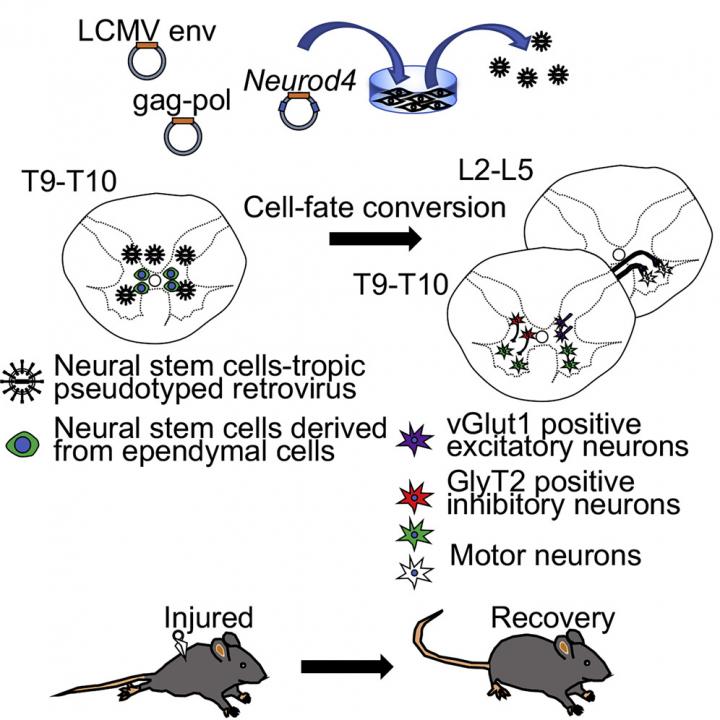
Credit: Atsushi Natsume
Nagoya University researchers have identified a gene that plays a crucial role in regenerating neurons of African clawed frog tadpoles, which has an unusually high capacity for nerve regeneration. Their study, recently published in the journal iScience, showed that introducing the gene into mice with spinal cord injury (SCI) led to a partial recovery of their lost motor functions. These findings could contribute to the development of a new therapy for SCI, which often causes a person to experience permanent and severe physical and neurological disabilities.
Repairing spinal cord injuries in humans and other mammals is difficult, partly because of their limited ability to repair and regenerate neural tissues in the spinal cord. In contrast, there are animals with a high capacity for nerve regeneration, such as the African clawed frog. “As a tadpole, it is fully capable of functional recovery after a spinal cord injury,” said Drs. Dasfne Lee-Liu and Juan Larrain from the P. Universidad Catolica de Chile in their study, “Genome-wide expression profile of the response to spinal cord injury in Xenopus laevis reveals extensive differences between regenerative and non-regenerative stages,” published in 2014.
In this context, the Nagoya University research team conducted a collaborative study with Drs. Lee-Liu and Larrain to identify transcription factors that regulate nerve regeneration in the African clawed frog tadpole, with the aim of inducing regenerative effects in mammals. The team comprehensively analyzed the gene expression profiles of tadpoles in response to SCI, and found that a gene called Neurod4 was expressed predominantly during nerve regeneration. The team thus hypothesized that this gene is a key factor in the regeneration of neural tissues after an injury.
In this study, the team also focused on the fact that in mammals, neural stem cells (known as self-renewing cells) derived from the ependymal cells lining the central canal of the spinal cord are activated and proliferate in the early stage of SCI, although these types of neural stem cells eventually transform into astrocytes — a type of cell that forms rigid glial scars.
“Taking these things together, we thought that introducing Neurod4 into activated neural stem cells may help regenerate neurons,” said Associate Professor Atsushi Natsume of the Nagoya University Graduate School of Medicine, the corresponding author of the study.
To that end, the team conducted experiments in which the Neurod4 gene was introduced to activated neural stem cells in mice just after SCI. The researchers observed that the neural stem cells were successfully converted into neurons and, interestingly, the mice occasionally moved their paralyzed hind legs. Dr. Natsume explained, “Neurod4 introduced into activated neural stem cells facilitates the production of relay neurons, which project to motor neurons of the hind legs. As a secondary effect, glial scar formation was suppressed after the subacute phase of spinal cord injury. This effect allows an environment that was conducive for axons to elongate beyond the injury site and form synapses, thereby improving the motor function of the hind legs.”
“Our method is to introduce a neuro regenerative gene directly into neural stem cells that are already present in the spinal cord. This could lessen the problems of rejection and tumor formation, which often occur in conventional stem cell transplantation methods. We believe this study will contribute to the development of new therapeutic approaches to spinal cord injury,” he added.
###
The study, “Neurod4 converts endogenous neural stem cells to neurons with synaptic formation after spinal cord injury,” was published in the journal iScience on January 20, 2021 at DOI?10.1016/j.isci.2021.102074.
Authors:
Toshiki Fukuoka, Akira Kato, Masaki Hirano, Fumiharu Ohka, Kosuke Aoki, Takayuki Awaya, Alimu Adilijiang, Sachi Maeda, Kuniaki Tanahashi, Junya Yamaguchi, Kazuya Motomura, Hiroyuki Shimizu, Yoshitaka Nagashima, Ryo Ando, Toshihiko Wakabayashi, Dasfne Lee-Liu, Juan Larrain, Yusuke Nishimura1, Atsushi Natsume
About Nagoya University, Japan
Nagoya University has a history of about 150 years, with its roots in a temporary medical school and hospital established in 1871, and was formally instituted as the last Imperial University of Japan in 1939. Although modest in size compared to the largest universities in Japan, Nagoya University has been pursuing excellence since its founding. Six of the 18 Japanese Nobel Prize-winners since 2000 did all or part of their Nobel Prize-winning work at Nagoya University: four in Physics – Toshihide Maskawa and Makoto Kobayashi in 2008, and Isamu Akasaki and Hiroshi Amano in 2014; and two in Chemistry – Ryoji Noyori in 2001 and Osamu Shimomura in 2008. In mathematics, Shigefumi Mori did his Fields Medal-winning work at the University. A number of other important discoveries have also been made at the University, including the Okazaki DNA Fragments by Reiji and Tsuneko Okazaki in the 1960s; and depletion forces by Sho Asakura and Fumio Oosawa in 1954.
Website: http://en.
Media Contact
Atsushi Natsume
[email protected]
Original Source
https:/
Related Journal Article
http://dx.




